Got low back pain? You and everyone else! As a spinal clinic in Nassau and Suffolk County, we frequently have patients coming to us with lower back pain. But even though it’s a very common source of discomfort, it’s a nebulous condition with many potential causes. Low back pain can be the result of a sedentary lifestyle but it can also be caused by overuse. It can be an acute symptom that goes away with physiotherapy but it can be a sign of an underlying condition, like arthritis or degenerative disc disease. Fortunately, in mild cases, there are things you can do to relieve back pain at home, including stretches and exercises designed to strengthen and relieve pressure on your lower back. And if there’s something more serious going on, our Harvard-trained spinal surgeon, Dr. Daniel Choi, is here to help. Read on for our favorite low back exercises.
First, a few words on the lumbar spine
Before we dive into any low back exercises, it’s important to understand exactly what the low back is and what it does. This area, also known as your lumbar spine, comprises the five vertebrae in your lower back. From supporting your upper body and distributing your body weight to enabling the movement of your trunk and legs, your lumbar spine has many critical functions in your day-to-day life. It’s also the center of your body’s balance so when it’s not functioning quite right, you’re going to feel it.
When it comes to stretching the lower back, you’ll want to proceed with caution and focus on proper form, especially if you’re recovering from an injury. Be gentle with yourself, be conscious of your alignment and be aware of your breathing. Find a comfortable place where you have room to stretch out and move. You should be able to breathe comfortably during each of the movements and you shouldn’t experience any pain.
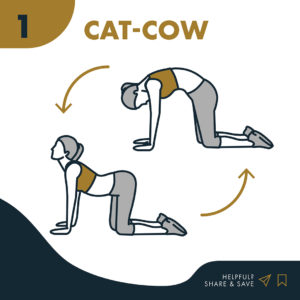
1. Cat-cow
Cat-cow is one of our favorite ways to warm up the entire spine when getting ready for movement. It allows you to move each vertebra of the spine, loosening up tight spots and soothing muscle soreness. Here’s how to do cat-cow:
- Start in tabletop position, on your hands and knees
- Make sure your hands are directly under your shoulders and your knees are under your hips
- Slowly arch your back — from your hips to your upper back — as you drop your belly towards the floor
- Hold for five seconds
- Then start to round your back, tucking your belly towards your spine (imagine an angry cat here)
- Hold for five seconds
- Repeat this movement 10 times
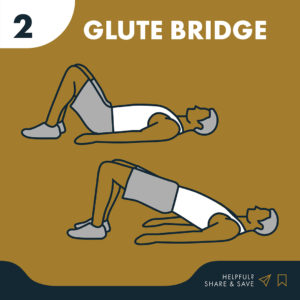
2. Glute bridge
Studies show that weak gluteus maximus muscles can contribute to pain in the lumbar spine. By strengthening the glutes, you can bring more stability to your lower back, reducing pain and increasing mobility in the process. Here’s how to perform a glute bridge:
- Start by laying on your back
- Bend your knees and place the soles of your feet flat on the floor
- Let your arms lay flat on the floor beside you, palms facing down
- Tuck your pelvis (think of a dog tucking its tail between its legs)
- Activate your glute muscles and start to roll your hips up off the floor
- Lift your hips until you’ve created a straight line from your shoulders through your pelvis to your knees
- Squeeze your glutes and hold for 2-5 seconds
- Slowly lower your hips without letting your low back arch (keep tucking your tail!) until your pelvis lands back down on the floor
- Repeat 10 times
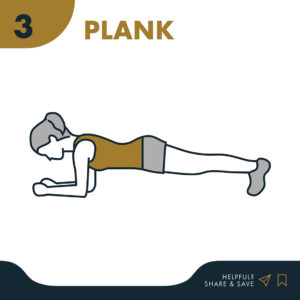
3. Plank
People most often think of planks as an abdominal exercise but planks can also help strengthen the lumbar spine and activate total body stability. It’s all about finding optimal alignment between the shoulders, hips and feet. Planks also offer plenty of variations and modifications so you can start incorporating planks into your daily routine no matter where you’re starting from. Here’s how to correctly do a plank:
- Start from tabletop position, on your hands and knees
- Make sure your wrists are directly under your shoulders and your knees are under your hips
- Activate your glutes and abdominal muscles
- Slowly lift your knees and walk your feet back to straighten your legs
- Protect your lower back by lengthening your lumbar spine towards your heels (think of that tucking action from your glute bridge)
- Make sure your hips are in line with your shoulders
- Squeeze your legs, glutes (and everything!) and hold for 15-30 seconds without allowing the pelvis to droop towards the floor
- Repeat five times
If this puts too much pressure on your wrists, you can also perform a plank from your forearms, keeping the elbows directly under the shoulders. You can also keep your knees on the floor to reduce strain on the lower spine and work your way up to knees lifted.
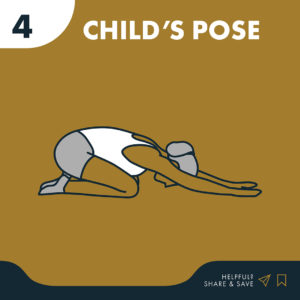
4. Child’s pose
Yoga practitioners will recognize child’s pose as one of the most restful and grounding yoga postures. This naturally relaxing pose brings your spine into an elongated position, helping relieve pressure on overburdened lower back muscles and encouraging healthy blood circulation. Here’s how to do it:
- Start from tabletop position, on your hands and knees
- Place your knees wider than your hips and bring your feet together with toes pointed
- Slowly sit your hips back towards your heels as you walk your hands out in front of you
- Your belly will come to rest on your thighs
- Hold for one minute
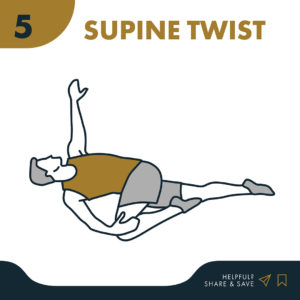
5. Supine twist
Twists are a great way to gently stretch both the low back and glute muscles, flushing away tightness and pain. They also support healthy mobility of the entire spine and, as an added bonus, massage your internal organs. Here’s how to do a supine twist:
- Start by laying on your back
- Bend your knees and place your feet flat on the floor
- Extend your arms out into a “T” on the floor
- Slowly let your knees fall to the left, keeping both shoulders pinned to the floor
- Hold for 30 seconds
- Bring your knees back to the center and then let them fall to the right
- Hold for 30 seconds
Your lower back is responsible for a lot of our day-to-day activities, from walking and running to carrying our kids or simply carrying the groceries. The best way to prevent low back pain from flaring up is regular strengthening and stretching. Of course, if you experience any significant discomfort with the above exercises and stretches for back pain, we urge you to stop. And if you think you need to speak with a spine specialist in Long Island, you know where to find us.



